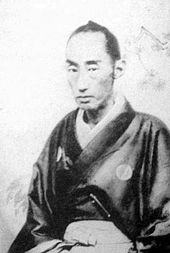Matsudaira Katamori
Matsudaira Katamori ( Japanese 松 平 容 保 ; * February 15, 1836 , † December 5, 1893 ) was a samurai who lived in the Bakumatsu period (end of the Edo period ) and the Meiji period . During the reign of the Tokugawa - shogunate in the Bakumatsu he was the ninth and last daimyo of Daimyats Aizu and for the safety of Kyoto responsible. Although he had fought on the side of the Shogunate in the dispute between Shogun and Tenno , his life was spared. After the Meiji Restoration , he was entrusted with the management of the Nikkō Tōshō-gū shrine . Together with three of his brothers he held an influential position, they were called "the four Takasu brothers".
biography
Matsudaira Katamori was born on February 15, 1836, the son of Matsudaira Yoshitatsu , the daimyō of the daimyat Takasu , and one of his concubines , a woman from the Komori family known by her Buddhist name Zenkyō-in . He was Yoshitatsu's seventh son and was called Keinosuke ( 銈 之 丞 ).
In 1846 he was adopted by Matsudaira Katanaka , the daimyo of Aizu. Matsudaira Teru was thus his adoptive sister. He married Katanaka's daughter Toshihime in 1865 . In 1852 Katamori became the 9th daimyo of Aizu and also inherited the honorary title of Higo no Kami ( governor of Higo ), which was traditionally inherited and inherited by the daimyo from Aizu.
In 1862 Katamori became Kyōtos military governor ( 京都 守護 職 , Kyōto shugo shoku ), which meant that it was his job to remove the city from the influence of the Sonnō-jōi followers. They demanded that foreigners should no longer enter Japan and advocated the removal of the shogunate. For this purpose, Katamori used, among other things, the Shinsengumi , a militant force that made Katamori a police unit and endowed it with extensive rights. Another unit, the Mimawarigumi , which had the same duties, was commanded by Katamori's brother Matsudaira Sadaaki . Katamori also played an important role in the coup d'états on September 30 and August 18, as well as the Forbidden Gates Rebellion , which greatly increased the hostility between Aizu and the daimyat Chōshū .
Katamori tried to find peaceful solutions after the Battle of Toba-Fushimi , in which the clashes between the Shogun and the Tennō or the new Meiji government reached a climax, but the members of the new Meiji government refused. This was mainly due to the fact that the majority of the members came from Chōshū and Satsuma and rejected Katamori because of his activities in Kyoto. Ultimately, the northern daimyates, including Aizu, were defeated, but Matsudaira's life was spared.
Matsudaira Katamori died on December 5, 1893 and was given the posthumous Shinto name Masane-unjin ( 忠誠 雲 神 , god of loyalty and righteousness ).
His adopted son, Matsudaira Nobunori, who was descended from the Mito branch of the Tokugawa family, became his heir. He left the Matsudaira family shortly after the Meiji Restoration , so that Matsudaira Kataharu, Katamori's eldest biological son, became the heir. He was the son of one of his two concubines and was born after Nobunori's adoption.
literature
- Noguchi Shin'ichi: 会 津 藩 . ( Aizu-han ) Gendai Shokan, Tokyo 2005, ISBN 4-7684-7102-1
- Tsunabuchi Kenjo (Ed.): 松 平 容 保 の す べ て . ( Matsudaira Katamori no subete ) Shin Jimbutsu Ōraisha, Tokyo 1984, ISBN 4-404-01245-4
- Yamakawa Hiroshi: Kyoto shugoshoku shimatsu Heibonsha, Tokyo 1965 (reprint of the original from 1911)
- Nakamura Akihiko: 松 平 容 保 は 朝 敵 に あ ら ず . ( Matsudaira Katamori wa chōteki ni arazu ) Chūōkōron shinsha, Tokyo 2000, ISBN 4-12-203604-6
- Kobiyama Rokurō: 写真 集 松 平 容 保 の 生涯 . ( Shashinshū: Matsudaira Katamori no shōgai ). Shin Jimbutsu Ōraisha, Tokyo 2003, ISBN 4-404-03108-4
Web links
| personal data | |
|---|---|
| SURNAME | Matsudaira, Katamori |
| ALTERNATIVE NAMES | 松 平 容 保 (Japanese) |
| BRIEF DESCRIPTION | Samurai and daimyo from Aizu |
| DATE OF BIRTH | February 15, 1836 |
| DATE OF DEATH | December 5, 1893 |

